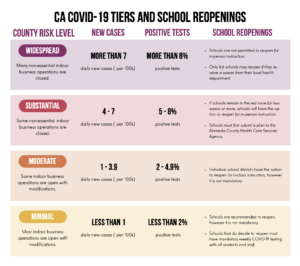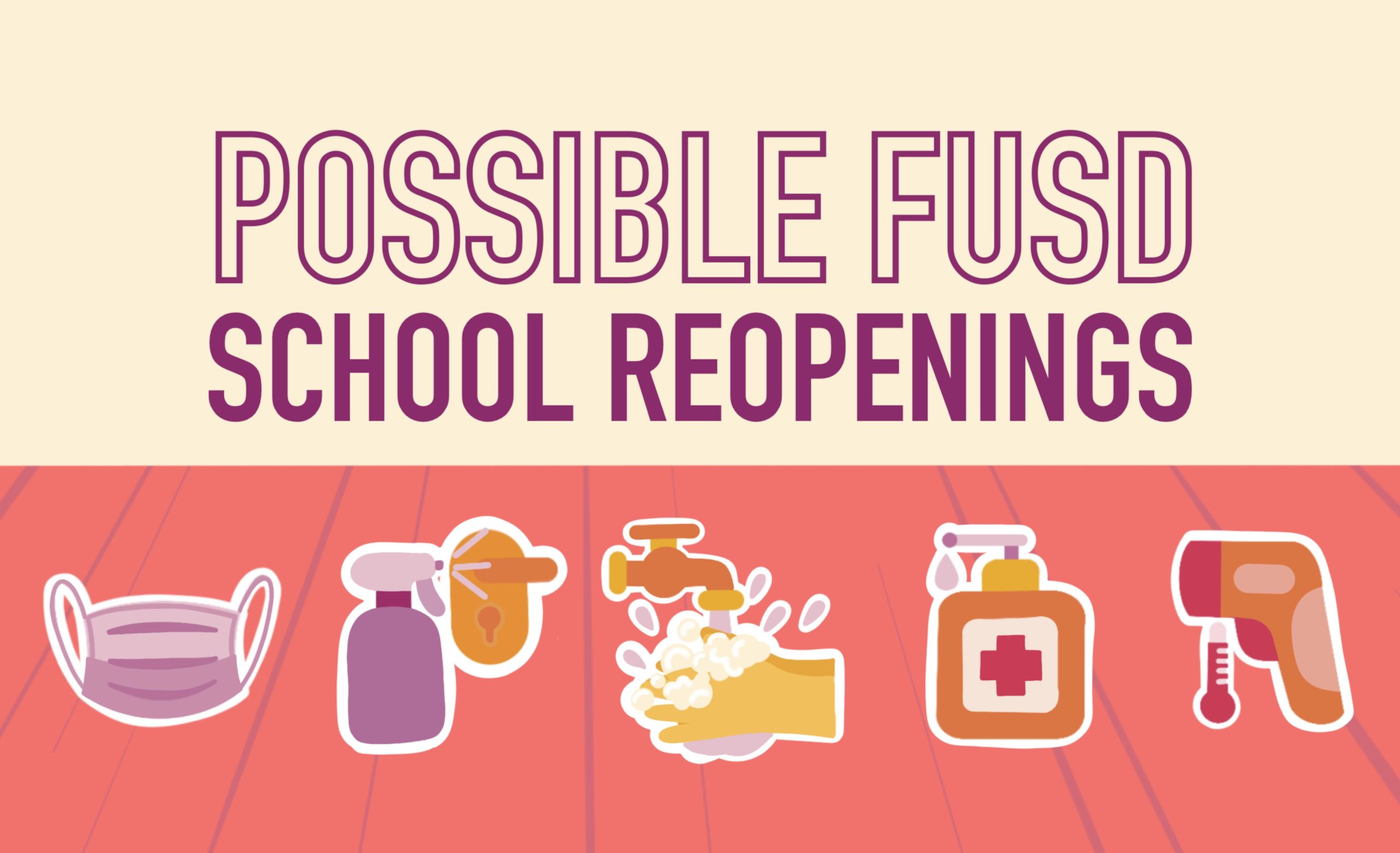By Staff Writers Maggie Lai, Naveed Shakoor, Mingxin Wang & Jackie Wong
The Alameda County Public Health Department recently announced that schools in the county would be able to reopen beginning November 9 if they have a comprehensive plan. This announcement was released by the county around two weeks after Alameda County’s COVID-19 status moved down from the “substantial” red zone to the “moderate” orange zone on October 13. To discuss the possible implications of reopening FUSD schools, the Smoke Signal reached out to students, faculty, Fremont Unified District Teachers Association (FUDTA) members, and Board of Education members.
Click the links below to jump directly to each recap.
COVID-19 Zones
The Decision-Making Process
The Transition Back to School
In-Person Instruction
COVID-19 Zones
A county can be recognized as four different zones — purple, red, orange, and yellow — depending on the number of COVID-19 cases the county reports. As of the date of publication, Alameda County has been in the orange zone for over two weeks. Information courtesy of the CA Department of Public Health
Information courtesy of the CA Department of Public Health
The Decision-Making Process
On October 28, Alameda County made a statement permitting elementary, middle, and high schools to reopen starting November 9. The county states that as of October 29, one public school, one charter, and 56 private schools have reopened or made the decision to reopen sometime soon. These schools and more information can be found on the Alameda County Office of Education’s website at acoe.org.
The FUSD COVID-19 Task Force, which consists of approximately 50 members including students, parents, administrators, and district bargaining units, has worked throughout the summer to flesh out the logistics of reopening schools. In a report from the July 10 Board of Education meeting, the task force detailed possible school reopening scenarios including in-person instruction, distance learning, and the hybrid model for the 2020-21 school year.
With this information along with public comments, the Board of Education voted on July 10 to start the school year with distanced learning for all schools in FUSD, and reevaluate the learning model when Alameda County has seen no new cases in 7 days.
However, with the recent developments with Alameda County’s COVID-19 status, FUSD released a parent/guardian survey to seek their input on school reopenings. These survey results will be discussed at their November 12 board meeting, where the FUSD Board of Education plans to consider possible time frames and plans for reopening.
If schools reopen, FUSD will be required to adhere to specific guidelines and safety measures set by the Alameda County Public Health Department, including regularly disinfecting classrooms, conducting health screenings, and requiring mask-use at all times.
Two of the most crucial factors to be considered before reopening schools are the costs that will come with reopening, such as regular health screenings and temperature readings for students and staff and the ability to successfully enforce social distancing policies.
FUSD Board Trustee Ann Crosbie said, “We’re gonna have to figure out not only can we safely open, but how do we afford to do so? … How do we have students that are far enough apart from each other and from any staff at any given time? How do we manage hand-washing when not all of our classrooms have sinks? How do you manage people using the restroom and not congregating too many at a time in an enclosed space?”
Another point FUSD is taking into consideration is the possibility of students and teachers being unwilling to return to school. According to Crosbie, there are already distance learning programs available for students should they not feel comfortable returning, but when it comes to teachers, she said, “I think it is a bigger issue if teachers and staff are unwilling to return because even if you wanted to push the point of them being essential workers and that they’re required to return, you can have teachers or staff just choose to quit, and during a teacher shortage, we can just end up in a situation where we just don’t have enough teachers if we don’t do this in collaboration with our teachers and staff.”
The ability to consistently disinfect campus also poses a challenge. “We only have so many custodians. We have close to 100 classrooms. Are they really going to be able to go into every single classroom every single day and specifically clean and highly disinfect every single classroom? … I honestly don’t know that we have the manpower to do that,” Assistant Principal Jeana Nightengale said.
FUDTA hosted a forum in early October to discuss the possibility of FUSD schools reopening. Half of the forum was spent hearing from out-of-state educators from Alaska, North Carolina, and Tennessee.
FUDTA President Victoria Birbeck-Herrera said, “Something that we are good at is trying to learn from people and experiences that others have had so we can make smarter decisions here. Looking at what school reopenings have looked like [in other states], and seeing that a lot of places are having to reclose schools is teaching us to be a lot more cautious.”
The Transition Back to School
Beginning on October 13, elementary schools in Alameda County with grades from transitional kindergarten, a bridge between preschool and kindergarten for 4-year-olds, to sixth grade are permitted to open for limited in-person instruction. In a recent announcement, Alameda County has announced that middle and high schools would be permitted to reopen as well.
Schools that choose to reopen on November 9 will be required to formulate a plan that adheres to CA and Alameda County Public Health Department’s guidance concerning health screenings, social distancing, facial coverings, and sanitation protocols. These plans must be submitted to Alameda County Office of Education for approval before making them available to the public.
The administration at MSJ, however, does not anticipate returning to in-person instruction this soon. “I don’t think we’ll be going back until there’s a vaccine … we haven’t considered a plan yet because first of all, we haven’t gotten the regulations from CA, Alameda County, and our district. So we would get those first, and then we would come up with an MSJ plan,” Nightengale said.
In-Person Instruction
If schools in FUSD make the decision to reopen, there is a list of criteria they need to meet during in-person instruction.
First, they need to follow the health guidelines set by Alameda County. These guidelines include a list for students and staff, and splitting students into consistent cohorts and spaces to minimize overall exposure.
Although these guidelines exist to ensure the safety of the students and staff, many students worry about their feasibility. Senior Varun Sridhar said, “I heavily doubt that we would be able to enforce social distancing because kids are going through hallways or talking to their friends during lunch, and the library’s always really packed. I think it’s pretty much impossible to keep track of every person and make sure that they’re enforcing proper social distancing.”
These guidelines set by Alameda County are the foundation of the new school protocols which ensure the safety of all students and staff. However, there are many more practices that are not explicitly stated on that list that students and staff are expected to follow.
The practices not included in Alameda County guidelines are expected to be in the school’s waiver — the intensive reopening plan. In the waiver, schools need to address sanitation, entrance protocols, health screenings, and communication plans. Teachers are expected to keep classrooms disinfected and sanitized after every class period and are expected to ensure that students have facial coverings on at all times and are following social distancing rules.
School heating, ventilation, and air conditioning (HVAC) systems would also need to be taken into account, as the US Government Accountability Office finds that more than 41 percent of school districts would need to update or replace their HVAC systems in at least half their buildings in order to limit COVID-19 transmittance. At MSJ, the aging HVAC systems have had numerous issues campus wide for many years, including malfunctions in November 2018 and earlier this year in January. A representative from the FUSD Maintenance Department declined to comment on this matter.
Additionally, there are a few different options for how class will actually work. The first option is to have class every day in cohorts — a small group of students banded together who work in the same classroom throughout the day. In secondary school, this would mean having teachers switch between classrooms while students stay in one room for the entire day.
The other option is hybrid cohorts, which is when students go to school on certain days and attend school virtually on other days. This breaks up the amount of time students spend together, while still giving them the opportunity to meet in their small groups. According to Crosbie, school will likely transition in this hybrid model, as it allows custodial staff more time to clean facilities regularly.
The health of staff and students still remains the priority for MSJ administration, however. “There’s a lot of people that have diabetes or asthma or other autoimmune diseases … and then to force them to come back, it just feels not fair; it feels wrong,” Nightengale said.
FUDTA President Victoria Birbeck-Herrera voices her concern about reopening campuses prematurely as well. “I’m very concerned about the safety [of teachers and students]. With such a large district, it is unfortunately all too easy to see the odds of something tragic happening with a return that isn’t very careful. If we don’t [follow safety precautions], it absolutely means that we will see colleagues that fall ill from COVID-19, or worse,” Birbeck-Herrera said.
Cover graphic by News Editor Alina Zeng


Be the first to comment on "Possible School Reopenings in FUSD"